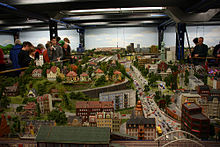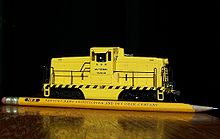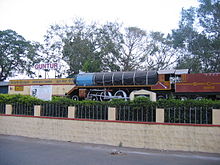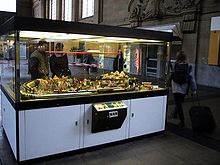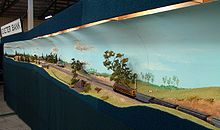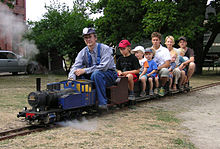- Rail transport modelling
-
Rail transport Operations Track Maintenance High-speed Gauge Stations Trains Locomotives Rolling stock Railways History Attractions Terminology By country Accidents
Modelling

 HO scale model railroad.
HO scale model railroad.
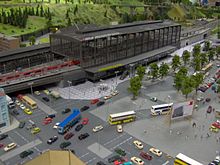 A scale model of Berlin's Bahnhof Zoo at the LOXX Berlin model railway.
A scale model of Berlin's Bahnhof Zoo at the LOXX Berlin model railway.
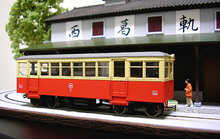 A Japanese HOe scale model railroad.
A Japanese HOe scale model railroad.
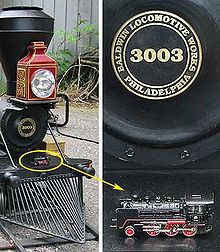 One of the smallest (Z scale, 1:220) placed on the buffer bar of one of the largest (live steam, 1:8) model locomotives.
One of the smallest (Z scale, 1:220) placed on the buffer bar of one of the largest (live steam, 1:8) model locomotives.
Railway modelling (UK, Australia, Ireland and Canada) or model railroading (US and Canada) is a hobby in which rail transport systems are modelled at a reduced scale. The scale models include locomotives, rolling stock, streetcars, tracks, signalling, and roads, buildings, vehicles, model figures, lights, and features such as streams, hills and canyons.
The earliest model railways were the 'carpet railways' in the 1840s. Electric trains appeared around the turn of the 20th century. But these were crude likenesses. Model trains today are more realistic. Today modellers create model railway / railroad layouts, often recreating real locations and periods in history.
Contents
General description
Involvement ranges from possession of a train set to spending hours and large sums on a large and exacting model of a railroad and the scenery through which it passes, called a "layout". Hobbyists, called "railway modellers" or "model railroaders", may maintain models large enough to ride (see Live steam, Ridable miniature railway and Backyard railroad). Modellers may collect model trains, building a landscape for the trains to pass through, or operate their own railroad in miniature.
Layouts vary from a circle or oval of track to realistic reproductions of real places modeled to scale. One of the largest is in the Pendon Museum in Oxfordshire, UK, where an EM gauge (same 1:76.2 scale as 00 but with more accurate track gauge) model of the Vale of White Horse in the 1930s is under construction. The museum also houses one of the earliest scenic models - the Madder Valley layout built by John Ahern. This was built in the late 1930s to late 1950s and brought in realistic modelling, receiving coverage on both sides of the Atlantic in the magazines Model Railway News and Model Railroader. Bekonscot in Buckinghamshire is the oldest model village and includes a model railway, dating from the 1930s. The world's largest model railroad in H0 scale is the Miniatur Wunderland in Hamburg, Germany. The largest live steam layout, with 25 miles (40 km) of track is Train Mountain in Chiloquin, Oregon, U.S..
Model railroad clubs exist where enthusiasts meet. Clubs often display models for the public. One specialist branch concentrates on larger scales and gauges, commonly using track gauges from 3.5 to 7.5 inches (89 to 191 mm). Models in these scales are usually hand-built and powered by live steam, or diesel-hydraulic, and the engines are often powerful enough to haul dozens of human passengers. Often railways of this size are called miniature railways.
The Tech Model Railroad Club (TMRC) at MIT in the 1950s pioneered automatic control of track-switching by using telephone relays.
The oldest society is The Model Railway Club (established 1910), near Kings Cross, London, UK. As well as building model railways, it has 5,000 books and periodicals. Similarly, The Historical Model Railway Society at Butterley, near Ripley, Derbyshire specialises in historical matters and has archives available to members and non-members.
Scales and gauges
Main articles: Rail transport modelling scales and Rail transport modelling standardsThe size of engines depends on the scale and can vary from 700 mm (27.6 in) tall for the largest ridable live steam scales such as 1:8, down to matchbox size for the smallest in Z-scale (1:220). However, there is another scale that was introduced in 2007 that is also commercially available, called T Gauge, it is 3 mm (0.118 in) gauge track and is a scale of 1:450, basically half the size of Z scale. A typical HO (1:87) engine is 50 mm (1.97 in) tall, and 100 to 300 mm (3.94 to 11.81 in) long. The most popular scales are: G gauge, Gauge 1, O gauge, S scale, HO gauge (in Britain, the similar OO), TT scale, and N scale (1:160 in the United States, but 1:144 in the UK). There is growing interest in Z scale and T Gauge. HO and OO are the most popular. Popular narrow-gauge scales include Sn3, HOn3 Scale and Nn3, which are the same in scale as S, HO and N except with a narrower spacing between the tracks (in these examples, a scale 3 ft (914 mm) instead of the 4 ft 8 1⁄2 in (1,435 mm) standard gauge).
The largest common scale is 1:8, with 1:4 sometimes used for park rides. G scale (Garden, 1:24 scale) is most popular for backyard modelling. It is easier to fit a G scale model into a garden and keep scenery proportional to the trains. Gauge 1 and Gauge 3 are also popular for gardens. O, S, HO, and N gauge are more often used indoors. Lionel trains in O scale (1:48 scale) are popular toys. S refers to 1:64 scale.
The words scale and gauge seem at first interchangeable but their meanings are different. Scale is the model's measurement as a proportion to the original, while gauge is the measurement between the rails.
At first, model railways were not to scale. Manufacturers and hobbyists soon arrived at de facto standards for interchangeability, such as gauge, but trains were only a rough approximation to the real thing. See Normen Europäischer Modelleisenbahnen (NEM) and NMRA. Official scales for the gauges were drawn up but not at first rigidly followed and not necessarily correctly proportioned for the gauge chosen. O (zero) gauge trains, for instance, operate on track too widely spaced in the United States as the scale is accepted as 1:48 whereas in Britain O gauge uses a ratio of 43.5:1 or 7 mm/1 foot and the gauge is near to correct. British OO standards operate on track significantly too narrow. The 4 mm/1 foot scale on a 16.5 mm (0.650 in) gauge corresponds to a track gauge of 4 ft 1 1⁄2 in/1,257 mm, 7 inches / 178 millimetres undersized). 16.5 mm (0.650 in) gauge corresponds to 4 ft 8 1⁄2 in (1,435 mm) standard gauge in HO (half-O) 3.5 mm/1 foot or 1:87. This arose due to British locomotives and rolling stock being smaller than those found elsewhere, leading to an increase in scale to enable HO scale mechanisms to be used. Most commercial scales have standards that include wheel flanges that are too deep, wheel treads that are too wide, and rail tracks that are too large.
Later, modellers became dissatisfied with inaccuracies and developed standards in which everything is correctly scaled. These are used by modellers but have not spread to mass-production because the inaccuracies and overscale properties of the commercial scales ensure reliable operation and allow for shortcuts necessary for cost control. The finescale standards include the UK's P4, and the even finer S4, which uses track dimensions scaled from the prototype. This 4 mm:1 ft modelling uses wheels 2 mm (0.079 in) or less wide running on track with a gauge of 18.83 mm (0.741 in). Check-rail and wing-rail clearances are similarly accurate.
A compromise of P4 and OO is 'EM' which uses a gauge of 18.2 mm (0.717 in) with more generous tolerances than P4 for check clearances. It gives a better appearance than OO though pointwork is not as close to reality as P4. It suits many where time and improved appearance are important. There is a small following of finescale OO which uses the same 16.5mm gauge as OO, but with the finer scale wheels and smaller clearances as used with EM- it is essentially 'EM-minus-1.7mm.'
Couplers and connectors
Main article: Coupling (railway)#Model trainsIn addition to different scales, there are also different types of couplers for connecting cars, which are not compatible with each other.
In H0, the Americans standardized on horn-hook, or X2F couplers, though these have largely given way to working knuckle couplers (Kadee) which are a close approximation to the "automatic" couplers used on the prototype there and elsewhere. Also in H0, the European manufacturers have standardized, but on a coupler mount, not a coupler: many varieties of coupler can be plugged in (and out) of the NEM coupler box. None of the popular couplers has any resemblance to the prototype three-link chains generally used on the continent.
For British modellers, whose most popular scale is 00, the normal coupler is a tension-lock coupler, which, again has no pretense of replicating the usual prototype three-link chain couplers. Bachmann and more recently Hornby have begun to offer models fitted with NEM coupler pockets. This theoretically enables modellers of British railways to substitute any other NEM362 coupler, though many Bachmann models place the coupler pocket at the wrong height. A fairly common alternative is to use represantations of chain couplings as found on the prototype, though these require large radius curves to be used to avoid derailments.
Other scales have similar ranges of non-compatible couplers available.
It must be emphasized that, in all scales, couplers can be exchanged, with varying degrees of difficulty.
Landscaping
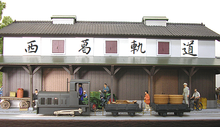 A HOe scale layout, 47 × 32 cm (18.5 × 12.6 in) in size.
A HOe scale layout, 47 × 32 cm (18.5 × 12.6 in) in size. The landscape in this N scale town includes weathered buildings and tall uncut grass.
The landscape in this N scale town includes weathered buildings and tall uncut grass.
 Scratch built HO Scale Model Coaling Tower, wood construction, showing weathering.
Scratch built HO Scale Model Coaling Tower, wood construction, showing weathering.
Some modellers pay attention to landscaping their layout, creating a fantasy world or modelling an actual location, often historic. Landscaping is termed "scenery building" or "scenicking".
Constructing scenery involves preparing a sub-terrain using a wide variety of building materials, including (but not limited to) screen wire, a lattice of cardboard strips, or carved stacks of expanded polystyrene (styrofoam) sheets. A scenery base is applied over the sub-terrain; typical base include casting plaster, plaster of Paris, hybrid paper-pulp (papier-mâché) or a lightweight foam/fiberglass/bubblewrap composite as in Geodesic Foam Scenery.[1] The scenery base is covered with ground cover, which may be ground foam, colored sawdust, natural lichen, or commercial scatter materials for grass and shrubbery. Buildings and structures can be purchased as kits, or built from cardboard, balsa wood, basswood, paper, or polystyrene or other plastic. Trees can be fabricated from materials such as Western sagebrush, candytuft, and caspia, to which adhesive and model foliage are applied; or they can be bought ready-made from specialist maunfacturers. Water can be simulated using polyester casting resin, polyurethane, or rippled glass. Rocks can be cast in plaster or in plastic with a foam backing. Castings can be painted with stains to give coloring and shadows.
Weathering
Weathering refers to making a model look used and exposed to weather by simulating dirt and wear on real vehicles, structures and equipment. Most models come out of the box looking new, because unweathered finishes are easier to produce and many collectors want models to look pristine. Also, the wear a freight car or building undergoes depends not only on age but where it is used. Rail cars in cities accumulate grime from building and automobile exhaust, while cars in deserts may be subjected to sandstorms which etch or strip paint. A model that is weathered would not fit as many layouts as a pristine model which can be weathered by its purchaser.
Weathering purchased models is common. At the least, weathering aims to reduce the plastic-like finish of scale models. The simulation of grime, rust, dirt, and wear add realism. Some modelers simulate fuel stains on tanks, or corrosion on battery boxes. In some cases, evidence of accidents or repairs may be added, such as dents or freshly painted replacement parts, and weathered models can be nearly indistinguishable from their prototypes when photographed appropriately.
Methods of power
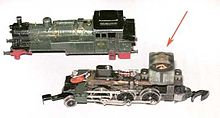 The sugar-cube sized electric motor in a Z scale model locomotive. The entire engine is only 50 mm (2") long.
The sugar-cube sized electric motor in a Z scale model locomotive. The entire engine is only 50 mm (2") long.
Model railway engines are generally operated by low voltage direct current (DC) electricity supplied via the tracks, but there are exceptions, such as Märklin and Lionel Corporation, which use alternating current (AC). Modern Digital Command Control (DCC) systems use alternating current. Other locomotives, particularly large models, used steam. Steam or clockwork driven engines are still sought by collectors.
Clockwork
Most early models for the toy market were powered by clockwork and controlled by levers on the locomotive. Although this made control crude the models were large and robust enough that grabbing the controls was practical. Various manufacturers introduced slowing and stopping tracks that could trigger levers on the locomotive and allow station stops.
Electricity
- Three-rail
Early electrical models used a three-rail system with the wheels resting on a metal track with metal sleepers that conducted power and a middle rail which provided power to a skid under the locomotive. This made sense at the time as models were metal and conductive. Modern plastics were not available and insulation was a problem. In addition the notion of accurate models had yet to evolve and toy trains and track were crude tinplate. A variation on the three-rail system, Trix Twin, allowed two trains to be independently controlled on one track, before the advent of Digital Command Control.
- Two-rail
As accuracy became important some systems adopted two-rail power in which the wheels were isolated and the rails carried the positive and negative supply or two sides of the AC supply.
- Stud contact
Other systems such as Märklin instead used fine metal studs to replace the central rail, allowing existing three-rail models to use more realistic track.
- Overhead line
Where the model is of an electric locomotive, it may be supplied by overhead lines, like the full-size locomotive. Before Digital Command Control became available, this was one way of controlling two trains separately on the same track. The electric-outline model would be supplied by the overhead wire and the other model (usually steam-outline) would be supplied by one of the running rails. The other running rail would act as a common return.
- Battery
Early electric trains ran on batteries because few homes in the late 19th century and early 20th century had electricity. Today, inexpensive train sets running on batteries are again common but regarded as toys and seldom used by hobbyists. Battery power is used by many garden railway and larger scale systems because of the difficulty in obtaining reliable power supply through the rails outdoors and because the high power consumption and thus current draw of large scale garden models is more easily and safely met with rechargeable batteries. Most large scale battery powered models use radio control.
Live steam
Engines powered by Live steam are often built in large, outdoor gauges, and are available in Gauge 1, G scale, 16 mm scale and can be found in 0 and H0. Hornby Railways produce live steam locomotives in 00, based on designs first arrived at by an amateur modeller. Other modellers have built live steam models in H0/00, 009 and N, and there is one in Z in Australia.[citation needed]
Internal combustion
Occasionally gasoline-electric models, patterned after real diesel-electric locomotives, come up among hobbyists and companies like Pilgrim Locomotive Works have sold such locomotives. Large-scale petrol-mechanical and petrol-hydraulic models are available but unusual and pricier than the electrically powered versions.
Scratch building
Modern manufacturing techniques mean mass produced models achieve a high degree of precision and realism.[citation needed] In the past this was not the case and scratch building was very common. Simple models are made using cardboard engineering techniques. More sophisticated models can be made using a combination of etched sheets of brass and low temperature castings. Parts that need machining, such as wheels and couplings are purchased. Etched kits are still popular, still accompanied by low temperature castings. These kits produce models that are not covered by the major manufacturers or in scales that are not in mass production. Laser machining techniques have extended this ability to thicker materials for scale steam and other locomotive types.
Control
The first clockwork (spring-drive) and live steam locomotives ran until out of power, with no way for the operator to stop and restart the locomotive or vary its speed. The advent of electric trains, which appeared commercially in the 1890s, allowed control of the speed by varying the current or voltage. As trains began to be powered by transformers and rectifiers more sophisticated throttles appeared, and soon trains powered by AC contained mechanisms to change direction or go into neutral gear when the operator cycled the power. Trains powered by DC can change direction by reversing polarity.
Electricity permits control by dividing the layout into isolated blocks, where trains can be slowed or stopped by lowering or cutting power to a block. Dividing a layout into blocks permits operators to run more than one train with less risk of a fast train catching and hitting a slow train. Blocks can also trigger signals or other accessories, adding realism or whimsy. Three-rail systems often insulate one of the common rails on a section of track, and use a passing train to complete the circuit and activate an accessory.
Many layout builders are choosing digital operation of their layouts rather than the more traditional DC design. The industry standard command system is Digital Command Control (DCC). The advantages to DCC are that track voltage is constant (usually in the range of 20 volts AC) and the command throttle sends a signal to small circuit cards, or decoders, hidden inside the piece of equipment which control several functions of an individual locomotive, including speed, direction of travel, lights, smoke and various sound effects. This allows more realistic operation in that the modeller can operate independently several locomotives on the same stretch of track. Less common closed proprietary systems also exist. Several manufacturers offer software that can provide computer-control of DCC layouts.
In large scales, particularly for garden railways, radio control and DCC in the garden have become popular.
Model railway manufacturers
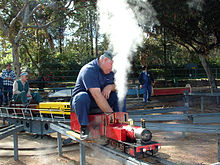 A model train running on the Willans Hill Model Railway miniature track in Wagga Wagga, New South Wales, Australia.
A model train running on the Willans Hill Model Railway miniature track in Wagga Wagga, New South Wales, Australia.
Magazines
Famous model railroaders
 Model train display at Chicago's Museum of Science and Industry
Model train display at Chicago's Museum of Science and Industry
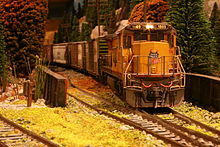 A model railway based on a fictional location in the United States.
A model railway based on a fictional location in the United States. Main article: list of rail transport modellers
Main article: list of rail transport modellersLayout standards organizations
Several organizations exist to set standardizations for connectability between individual layout sections (commonly called "modules"). This is so several (or hundreds, given enough space and power) people or groups can bring together their own modules, connect them together with as little trouble as possible, and operate their trains. Despite different design and operation philosophies, different organizations have similar goals; standardized ends to facilitate connection with other modules built to the same specifications, standardized electricals, equipment, curve radii.
- NTRAK, standardized 3-track (heavy operation) mainline with several optional branchlines. Focuses on Standard Gauge, but also has specifications for Narrow Gauge. Due to its popularity, it can be found in regional variations, most notably the Imperial-to-Metric measurement conversions. Tends to be used more for 'unattended display' than 'operation'.
- FREMO,[2] a European-based organisation focusing on a single-track line, HO Scale. Also sets standards for N Scale modules. Standards are considerably more flexible in module shape than NTRAK, and has expanded over the years to accommodate several scenery variations.
- oNeTRAK,[3] operationally similar to FREMO, standardises around a single-track mainline, with modules of varying sizes and shapes. Designed with the existing NTRAK spec in mind, is fully compatible with such modules.
- Z-Bend Track,[4] uses a double track mainline running down both sides of a module. Modules can be of any length, or width in the middle and any overall shape. The "standard" called Z-Bend Track only applies to the last five inches (12.7 cm) of the module’s interface to other modules, the electrical interface and the module height.
- ausTRAK,[5] N Scale, two-track main with hidden third track (can be used as NTRAK's third main, as a return/continuous loop, or hidden yard/siding/on-line storage). Australian scenery and rolling stock modelled in Standard Gauge.
- NMRA, National Model Railroad Association, the largest organization devoted to the development, promotion, and enjoyment of the hobby of model railroading.
- MOROP, European Union of Model Railroad and Railroad Fans, the European standardization organisation.
- sTTandard,[6] Polish TT-scale (1:120) modules organization.
- N-orma,[7] Polish N-scale (1:160) modules organization.
See also
- Brass model
- Lego train
- List of model railroad clubs
- Rail transport modelling scales
- Rail transport modelling standards
- Scale model
- Standard gauge in Model railways
- Toy train
- Track layout possibilities
- Train game
- Wide gauge in Model railways
Displays and famous layouts
- Bekonscot - The oldest model village in the world, featuring a large model railway network
- Carnegie Science Center's Miniature Railroad & Village in Pittsburgh
- Clemenceau Heritage Museum, elaborate model railroad display depicts the seven railroads that operated in the Upper Verde Valley of Arizona, 1895–1953
- Gorre & Daphetid
- Miniatur Wunderland
- Northlandz
- San Diego Model Railroad Museum
- The Great Train Story exhibit at Museum of Science and Industry (Chicago)
- The Toy Train Depot - A museum dedicated to the history of scale model railroading in Alamogordo, New Mexico
- Virginian and Ohio
Groups dedicated to railway modelling
- Railways of Germany Group
- German Railway Society
References
- ^ http://www.bragdonent.com/gfguide.htm
- ^ "FREMO homepage" (in German, English). http://www.fremo.org/inhalt_d.htm.
- ^ "oNeTrack homepage". http://www.nvntrak.org/nb/onetrak.php.
- ^ "Z-Bend Track homepage". http://www.zbendtrack.com.
- ^ "ausTRAK website". http://home.vicnet.net.au/~vnsc/austrak.htm.
- ^ "sTTandard homepage". http://www.sttandard.org.pl/.
- ^ "N-orma homepage". http://www.n-orma.pl/.
External links
- The National Model Railroad Association, USA - the largest model railroad organization in the world
- The Model Railway Club, UK - the oldest known society in the world - established 1910
Architectural models · Brass models · Building models · Diecast models · Model aircraft · Model cars · Model commercial vehicles · Model construction vehicles · Model figures · Matchstick models · Model military vehicles · Dioramas · Model robots · Model trains · Model rockets · Model ships · Gundam model · Miniature wargaming · 1:6 scale modelingCategories:- Rail transport modelling
- Rail transport
- Miniature railways
Wikimedia Foundation. 2010.


